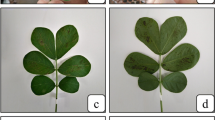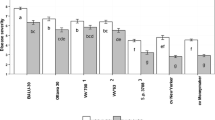Abstract
The C-biotype of Moniliophthora perniciosa is the causal agent of witches’ broom disease of Theobroma cacao L. While this disease is of major economic importance, the pathogenicity mechanisms and plant responses underlying the disease are difficult to study given the cacao tree’s long life cycle and the limited availability of genetic and genomic resources for this system. The S-biotype of M. perniciosa infects solanaceous hosts, particularly pepper (Capsicum annuum) and tomato (Solanum lycopersicum). These species are much more amenable for performing studies of mechanisms underpinning host-pathogen interactions as compared to cacao. A phylogenetic analysis performed in this study demonstrated that S-biotype strains clustered with C-biotype strains, indicating that these biotypes are not genetically distinct. A comparative analysis demonstrated that disease progression in tomato infected with the S- biotype is similar to that described for cacao infected with the C- biotype. The major symptoms observed in both systems are swelling of the infected shoots and activation and proliferation of axillary meristems. Cellular changes observed in infected tissues correspond to an increase in cell size and numbers of xylem vessels and phloem parenchyma along the infected stem. Observations revealed that fungal colonization is biotrophic during the first phase of infection, with appearance of calcium oxalate crystals in close association with hyphal growth. In summary, despite different host specificity, both biotypes of M. perniciosa exhibit similar disease-related characteristics, indicating a degree of conservation of pathogenicity mechanisms between the two biotypes.






Similar content being viewed by others
References
Abramoff MD, Magelhaes PJ, Ram SJ (2004) Image processing with imageJ. Biophotonics 11(7):36–42
Aime MC, Phillips-Mora W (2005) The causal agents of witches’ broom and frosty pod rot of cacao (chocolate, Theobroma cacao) form a new lineage of Marasmiaceae. Mycologia 97(5):1012–1022
Anderbrhan T, Furtek DB (1994) Random amplified polymorphic DNA (RAPD) analysis of Crinipellis perniciosa isolates from different hosts. Plant Pathol 43:1020–1027
Bastos CN, Anderbrhan T, Almeida LC (1988) Morphological and pathological comparison of Crinipellis perniciosa isolates. Fitopatol bras 13(3):2002–2006
Bastos CN, Evans HC (1985) A new pathotype of Crinipellis perniciosa (Witches’ broom disease) on solanaceous hosts. Plant Pathol 34:306–312
Bowers JH, Bailey BA, Hebbar PK, S.Sanogo, and Lumsden RD (2001) The impact of plant diseases on world chocolate production. In APS net features. Available via http://www.apsnet.org/online/feature/cacao/
Ceita GO, Macedo JNA, Santos TB, Alemanno L, Gesteira AS, Micheli F, Mariano AC, Gramacho KP, Silva DC, Meinhardt L, Mazzafera P, Guimaraes Pereira GA, Cascardo JCM (2007) Involvement of calcium oxalate degradation during programmed cell death in Theobroma cacao tissues triggered by the hemibiotrophic fungus Moniliophthora perniciosa. Plant Sci 173:106–117
Cronshaw DK, Evans HC (1978) Witches’ broom disease of cocoa (Crinipellis perniciosa) in Ecuador. II- Methods of infection. Ann Appl Biol 89:193–200
de Arruda MCC, Sepulveda GF, Miller RNG, Ferreira MASV, Santiago DVR, Resende MLV, Dianese JC, Felipe MSS (2005) Crinipellis brasiliensis, a new species based on morphological and molecular data. Mycologia 97(6):1348–1361
do Rio MCS, de Oliveira BV, de Tomazella DPT, da Silva JAF, Pereira GAG (2008) Production of calcium oxalate crystals by the basidiomycete Moniliophthora perniciosa, the causal agent of Witches’ Broom disease of cacao. Curr Microbiol 56(4):363–370
Dutton MV, Evans CS (1996) Oxalate production by fungi: its role in pathogenicity and ecology in the soil environment. Can J Microbiol 42(9):881–895
Evans HC (1978) Witches’ broom disease of cocoa (Crinipellis perniciosa) in Ecuador. I- The fungus. Ann Appl Biol 89:185–192
Evans HC (1980) Pleomorphism in Crinipellis perniciosa, causal agent of witches’ broom disease of cocoa. Trans Br Mycol Soc 74(3):515–523
Evans HC, Barreto RW (1996) Crinipellis perniciosa: a much investigated but little understood fungus. Mycologist 10(2):58–61
Frias GA, Purdy LH (1991) Infection biology of Crinipellis perniciosa on vegetative flushes of cacao. Plant Dis 75:552–556
Glickmann E, Gardan L, Jacquet S, Hussain S, Elasri M, Petit A, Dessaux Y (1998) Auxin production is a common feature of most pathovars of Pseudomonas syringae. Mol Plant Microbe Interact 11(2):156–162
Gramacho KP (1999) Disease resistance and pathogenic variability in the fusiform rust-slash pine pathosystem. Dissertation, University of Florida
Griffith GW, Hedger JN (1993) A novel method for producing basidiocarps of the cocoa pathogen Crinipellis perniciosa using a bran-vermiculite medium. Neth J Plant Pathol 99:227–230
Griffith GW, Hedger JN (1994) Spatial distribution of mycelia of the liana (L-) biotype of the garic Crinipellis perniciosa (Stahel) Singer in tropical forest. New Phytol 127:243–259
Griffith GW, Nicholson J, Negnninger A, Birch RN, Hedger JN (2003) Witches’ brooms and frosty pods: two major pathogens of cacao. New Zeal J Bot 41:423–435
Hagen G, Guilfoyle T (2002) Auxin-responsive gene expression: genes, promoters and regulatory factors. Plant Mol Biol 49:373–385
Ihaka R, Gentleman R (1996) R: a language for data analysis and graphics. J Comput Graph Stat 5(3):299–314
Jameson PE (2000) Cytokinins and auxins in plant-pathogen interactions—An overview. Plant Growth Regul 32(2–3):369–380
Jefferson RA, Kavanagh TA, Bevan MW (1987) Gus fusions—beta-glucuronidase as a sensitive and versatile gene fusion marker in higher-plants. Embo J 6(13):3901–3907
Kilaru A, Bailey BA, Hasenstein KH (2007) Moniliophthora perniciosa produces hormones and alters endogenous auxin and salicylic acid in infected cocoa leaves. FEMS Microbiol Lett 274(2):238–244
Krupasagar V, Sequeira L (1969) Auxin destruction by Marasmius perniciosus. Am J Bot 56(4):390–397
Kumar S, Tamura K, Nei M (2004) MEGA3: integrated software for molecular evolutionary genetics analysis and sequence alignment. Brief Bioinform 5:150–163
Kurrein F, Green G, Rowles S (1975) Localized deposition of calcium oxalate around a pulmonary Aspergillus niger fungus ball. Am J Clin Pathol 64:556–563
Leyser O (2003) Regulation of shoot branching by auxin. Trends Plant Sci 8(11):541–545
Meinhardt LW, Rincones J, Bailey BA, Aime MC, Griffith GW, Zhang DP, Pereira GAG (2008) Moniliophthora perniciosa, the causal agent of witches’ broom disease of cacao: what’s new from this old foe? Mol Plant Pathol 9(5):577–588
Mondego JMC et al. (2008) A genome survey of Moniliophthora perniciosa gives new insights into witches’ broom disease of cacao. BMC Genomics, 9
Niella GR, Resende MI, Castro HA, Silva LHCP, Carvalho JA (1999) Aperfeicoamento da metodologia de producao artificial de basidiocarpos de Crinipellis perniciosa. Fitopatol bras 23:523–527
Orchard J, Collin HA, Hardwick K, Isaac S (1994) Changes in morphology and measurement of cytokinin levels during the development of witches’ broom on cocoa. Plant Pathol 43:65–72
Pires ABL, Gramacho KP, Silva DC, Goes-Neto A, Silva MM, Muniz-Sobrinho JS, Porto RF, Villela-Dias C, Brendel M, Cascardo JCM, Pereira GAG (2009) Early development of Moniliophthora perniciosa basidiomata and developmentally regulated genes. BMC Microbiol 9:18
Ploetz R, Shnell RJ, Ying Z, Zheng Q, Olano CT, Matamayor JC, Johnson ES (2005) Analysis of molecular diversity in Crinipellis perniciosa with AFLP markers. Eur J Plant Pathol 111:317–326
Purdy LH, Schmidt RA (1996) Status of cacao witches broom: biology, epidemiology, and management. Ann Rev Phyto 34:573–594
Radzali BM, Hamish AC, Issac S, Hardwick K (1996) Effects of the fungus Crinipellis perniciosa, causal agent of witches’ broom disease, on cell and tissue cultures of cocoa (Theobroma cacao L.). Plant Pathol 45:145–154
Rincones J, Mazotti GD, Grifith GW, Pomela A, Figueira A, Leal GA, Queiroz MV, Pereira JF, Azevedo RA, Pereira GAG, Meinhardt LW (2006) Genetic variability and chromosome-length polymorphisms of the witches’ broom pathogen Crinipellis perniciosa from various parts in South America. Mycol Res 110:821–832
Rincones J, Scarpari LM, Carazzolle MF, Mondego JMC, Formighieri EF, Barau JG, Costa GGL, Carraro DM, Brentani HP, Vilas-Boas LA, de Oliveira BV, Sabha M, Dias R, JlM C, Azevedo RA, Meinhardt LW, Pereira GAG (2008) Differential gene expression between the biotrophic-like and saprotrophic mycelia of the witches’ broom pathogen Moniliophthora perniciosa. Mol Plant Microbe Interact 21(7):891–908
Scarpari LM, Meinhardt LW, Mazzafera P, Pomella AWV, Schiavinato MA, Cascardo JCM, Pereira GAG (2005) Biochemical changes during the development of witches’broom: the most important disease of cocoa in Brazil caused by Crinipellis perniciosa. J Exp Bot. 56(413):865–877
Schwalm K, Aloni R, Langhans M, Heller MW, Stich S, Ullrich CI (2003) Flavonoid-related regulation of auxin accumulation in Agrobacterium tumefaciens-induced plant tumors. Planta 218:163–178
Silva SDVM, Luz EDMN, Almeida LC, Gramacho KP, Bezerra JL (2002) Redescicao da sintomatologia causada por Crinipellis perniciosa em cacaueiro. Agrotropica 14(1):1–10
Sreenivasan TN, Dabydeen S (1989) Modes of penetration of young cocoa leaves by Crinipellis perniciosa. Plant Dis 73:478–481
Stahel G (1919) Contribution to the knowledge of witchbroom disease. Trop Agr 4(6):167–176
Surujdeo S, Umaharan P, Butler DR, Sreenivasan TN (2003) An optimized screening method for identifying levels of resistance to Crinipellis perniciosa in cocoa (Theobroma cacao). Plant Pathol 52:464–475
Taiz L, Zeiger E (1998) Plant physiology. Sinauer Associates, Inc., Sunderland
Thomson D, Henry RJ (1993) Single step protocol for preparation of plant tissue for analysis by PCR. Biotechniques 19:394–397
Vaughan RE (1914) A method for the differential staining of fungus and host cells. Ann Mo Bot Gard 1:241–242
Acknowledgements
We would like to thank Dr. Majid Foolad (The Pennsylvania State University, Department of Horticulture) for providing tomato seeds (NC841.73). Thanks to Dr Paul Backman for useful comments and for providing lab space to work with the pathogen under containment conditions. Thanks also to Ruth Haldeman, Susan Mogargee and Elaine Kunze for technical assistance with microscopy and to Dr. Sook-Young Park for her technical assistance with molecular techniques. This work was supported in part by the American Cocoa Research Institute Endowed Program in the Molecular Biology of Cocoa, by Grants to M.J.G. from the World Cocoa Foundation and the United States Department of Agriculture Office of International Research Programs, and by support from the Departments of Plant Pathology and Horticulture, Agricultural Experiment Station of The Pennsylvania State University (CRIS 3550).
Author information
Authors and Affiliations
Corresponding author
Additional information
Communicated by: Schuyler S. Korban
Rights and permissions
About this article
Cite this article
Marelli, JP., Maximova, S.N., Gramacho, K.P. et al. Infection Biology of Moniliophthora perniciosa on Theobroma cacao and Alternate Solanaceous Hosts. Tropical Plant Biol. 2, 149–160 (2009). https://doi.org/10.1007/s12042-009-9038-1
Received:
Accepted:
Published:
Issue Date:
DOI: https://doi.org/10.1007/s12042-009-9038-1




